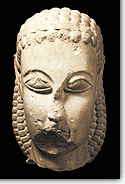







     | |
  |
|
|
We know a very small number of kouroi from eastern Greece, with Samos the only exception , where some fairly good examples were found. The sculptors within the sphere of interest of Ionic art created some forms with flowing outlines and with a schematic to decorative representation of their anatomy. The heads are extremely spherical, the hair-styles are stereotypic towards the back and the eyes are almond-shaped. These elements had a rather oriental origin and were incorporated into the plastic idiom of the West (Etruria, Magna Graecia) via the colonies of Phocaea.
The male forms in Ionia are often found dressed, whereas the seated type (of men and women), already known from the Daedalic style, is widely spread. The lax interest in anatomy, was balanced by a special sensitivity ino the representation of the garments of kouroi. The most interesting examples come from Chios, Samos and Miletus. The eminent group of Geneleos from Samos includes a seated and a recumbent form next to some typical korai with a cylindrical body, displaying the influence of the old oriental technique of curving on a tree trunk.
In the Cyclades the known kouroi come from Thera, Melos, Delos, Paros and Naxos. We know with certainty that only the last two islands had their own workshops. The Cycladic kouroi differ from those of Ionia, both in the head and the slender outlines and the gracious forms. Furthermore some of the korai in Acropolis are most probably connected to the Naxian workshop, whereas a related tradition is revealed in the korai-caryatids of the treasury of Siphians in Delphi. The statue of the winged Nike in a kneeling pose presents a special interest. It was found in Delos and is attributed to the sculptor Archermus of Chios, who worked in Athens as well.
|
In Attica the kouroi were widely spread as a grave markers. Of them the earliest ones, such as the head of Dipylon and the kouros of Sounion, still belong to the end of the 7th or at the beginning of the |  |
|
| |
|
Note: Click on picture for short description. | |